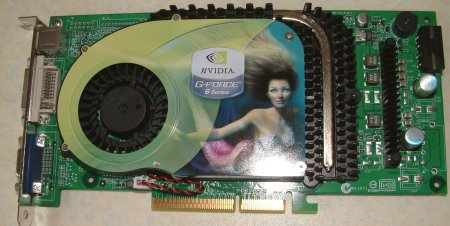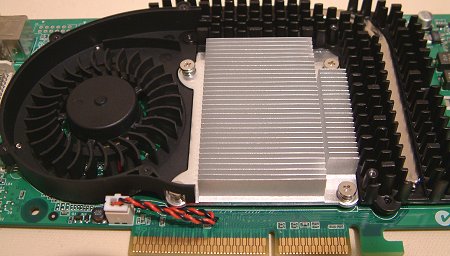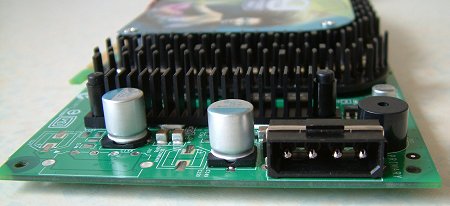Appearance
As mentioned, Ultra and GT GeForce 6800s are distinguished via clock and memory speed alone. There's also a basic 6800 that runs with a 12-pipe rendering setup and supports older, slower DDR. Ryszard summarises the key differences succinctly, here.
Back to AOpen's GeForce 6800 GT. One immediately recognisable difference between GT and Ultra models is card appearance. A regular 6800 Ultra uses a much chunkier GPU heatsink, 2 Molex power connectors, a double-height back panel and runs with dual-DVI as standard. By contrast, AOpen's GeForce 6800 GT is a more conventional-looking card, using a single-slot cooler and one Molex connector. It makes one wonder if Ultras are simply overclocked, overvolted GTs in disguise. The back of the card can be found, here. Again, notice that it's just a reference design with no additional VIVO functionality.
NVIDIA's gone about memory cooling in a different way for the 6800-series. It used to be the case that memory was partially cooled by the GPU's fan, with windflow being channelled through a set of aluminium or copper fins. This time, though, NVIDIA incorporates proven heatpipe technology to wick away excess heat from 256MB GDDR3 modules running at 1GHz.

Whipping away the cooler's cover shows a relatively small aluminium heatsink. NVIDIA and its partners are obviously confident that it, along with the active cooling, can keep 222m transistors running at a core speed of 350MHz. The GT core, by having an insane amount of transistors, is much larger than any CPU's.

We can clearly see that left-hand PCB space is reserved for a second Molex connector. AOpen's stuck with the reference design to the absolute letter. There's not even an AOpen sticker to be found on either side of the card. The state of current play is that board partners seem happy to package pure reference cards, add in a couple of personalised bundle touches, and be done with it. The days of wild and wacky design seem to be a distant, hazy memory.

A lack of a VIVO chip means that S-Video simply performs as a conduit for TV-Out. DVI-I and VGA ports could grace any card from the past 5 years. All in all, a reference design in every detail. There's nothing wrong with that, it's just a touch disappointing not to see a wide range of custom cooling designs now.









